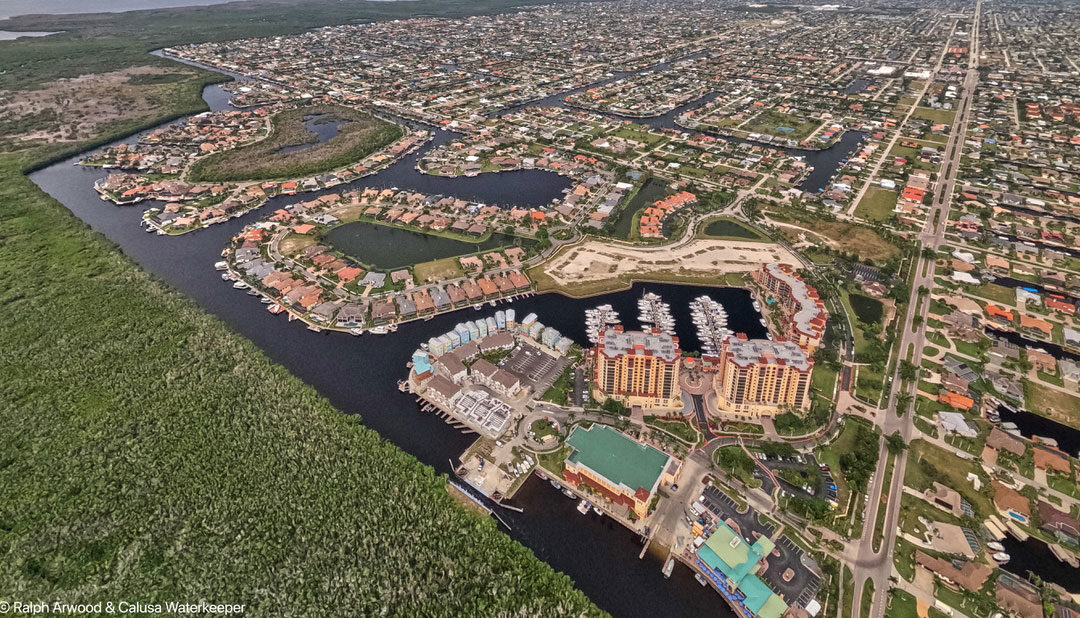The BMAP for the City of Cape Coral sets a target for removal of nitrogen from the surrounding waters at 38,965 lbs. of nitrogen per year. The Department and the City of Cape Coral claim to have overachieved this target, relying on “credits” assigned by the Department to off-set the City’s yearly goal. The problem, testified Mr. Cassani, is that the goal was established in 2012. The Department has never updated the goal, consistent with actual data collected on a timely basis in the waters around Cape Coral. Petitioners’ representative in the trial, J. Michael Hannon, says that in so doing, the BMAP program only falls further behind while creating the illusion that restoration of water quality is on track.
Mr. Cassani cited documents submitted by the City of Cape Coral to FDEP in 2015 and 2020 reporting on the efficiencies of the City’s Stormwater Management System. Both reports reveal that the major outfalls of the City delivering stormwater to its canals and then into the Matlacha Pass and the Caloosahatchee River actually produce on an annual basis much more nitrogen than the BMAP target of 38,965 lbs. of nitrogen per year. The 2015 report stated that 251,148 lbs. of nitrogen was discharged in 2014. The 2020 report stated that 923,703 lbs. of nitrogen was discharged in 2019.
Mr. Cassani testified that this should come as no surprise to the Department of Environmental Protection. The Department is required by the Florida Legislature to prepare a “5-Year Review” of the BMAP system. The 2022 5-Year Review confirmed that the amount of nitrogen being delivered by polluters in the various watersheds is actually 1,207,239 lbs. per year more than the target set in 2012. The City will likely be required to address its share of the increase in the next 5-year review starting around 2027. This process, however, lags way behind actual pollution numbers.
The 2022 5-Year Report, which is sent to the Governor, states: “Considering the increased loading shown by monitoring data, and the recent increase in the size of the Caloosahatchee River and Estuary BMAP, it is unlikely that currently underway and planned projects will be enough to meet the 20-year milestone for the Caloosahatchee River Watershed.” Mr. Hannon states that not many residents of this area are aware that the BMAP goals used by the Department do not expect the pollutant loads in the State to be remediated until 2032. Now the Department recognizes that even that goal cannot realistically be achieved.
The conclusion to be drawn is obvious: the goals for remediation of pollution in the waters of the State of Florida are not adequately evaluated in a real time context under the Department’s use of the BMAP system. Therefore, said Mr. Cassani, the cumulative rate of pollution worsens, making it more expensive to eventually restore the Caloosahatchee River.
The trial is scheduled to resume at a future date for the presentation of rebuttal testimony from the City and the Department.
The Petitioners in the trial long ago proposed a compromise to removing the dysfunctional Chiquita Lock. Petitioners support construction of a high-speed dual lock. In 2006-07, The City of Cape Coral actually applied for and received a Department Permit to replace the Chiquita Lock with a dual lock system. The City extended the Permit an additional five years; however, the City never built the dual lock system. In May of 2022, the City produced an estimate of the cost of building a new parallel lock system at $30,933,968.
Petitioners’ conducted a review of the City of Cape Coral’s income from property taxes. In 2018 the City realized $86 million from property taxes. The City anticipates receiving $132 million from property taxes in 2024. The City Council and Mayor report their view that the population of the City will top out at 400,000, with a 2022 reported population of 208,253. Petitioners’ investigation revealed that at the end of most budget years in the past decade, the City has generally realized a surplus of $10-20 million, which was allocated at year end to special projects.
Learn More About the History of the Chiquita Lock

























